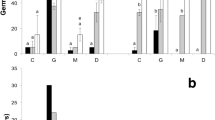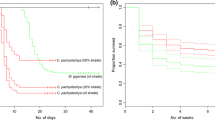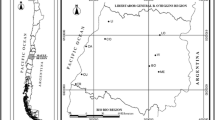Abstract
Germination of wild and managed populations of columnar cacti was compared to analyze differences associated to management intensity. The species studied: Polaskia chende, Escontria chiotilla, Myrtillocactus schenckii, Polaskia chichipe, and Stenocereus pruinosus are in a gradient from lower to higher management intensity, respectively. Within each species wild, silvicultural, and cultivated populations also represent a gradient from lower to higher management intensity. We hypothesized that seeds of plants under higher management intensity would require more water to germinate than others since managed environments are relatively wetter than unmanaged environments. Such pattern could be visualized within and among species according to management intensity. We tested germination of seeds from different populations of the different species to the water potentials: 0.0, −0.2, −0.4, −0.6, −0.8, and −1.0 MPa. In all species studied seeds of managed populations had significantly more mass than seeds from wild populations. Each species had different susceptibility to water availability decrease, which could be related to particular adaptations to drought resistance. Stenocereus pruinosus and Polaskia chende were the most and least susceptible species, respectively. In control treatments of all species, seeds of managed populations had higher germination rate than seeds from wild populations, but when water availability decreased the pattern was the contrary. Our results suggest that artificial selection for larger fruits and heavier seeds in plants established in wetter environments have affected germination patterns. Although species have particular critical points of water availability for germination, differences in germination patterns are more pronounced according to management and artificial selection intensity.






Similar content being viewed by others
References
Arellano E, Casas A (2003) Morphological variation and domestication of Escontria chiotilla (Cactaceae) under silvicultural management in Tehuacán Valley, Central Mexico. Genet Resour Crop Evol 50:439–453
Ayala-Cordero G, Terrazas T, López-Mata L, Trejo C (2004) Variación en el tamaño y peso de la semilla y su relación con la germinación en una población de Stenocereus beneckei. Interciencia 29:692–697
Blancas J, Casas A, Lira R, Caballero J (2009) Traditional management and morphological patterns of Myrtillocactus schenckii (Cactaceae) in the Tehuacán Valley, Central Mexico. Econ Bot 63:375–387
Casas A (2001) Silvicultura y domesticación de plantas en Mesoamérica. In: Rendón-Aguilar B, Rebollar DS, Caballero JN, Martínez AM (eds) Plantas, cultura y sociedad: estudio sobre la relación entre seres humanos y plantas en los albores del siglo XXI. Universidad Autónma Metropolitana, México, pp 123–158
Casas A, Caballero J, Valiente-Banuet A (1999a) Use, management and domestication of columnar cacti in south central México: a historical perspective. J Ethnobiol 19:71–95
Casas A, Valiente-Banuet A, Rojas-Martínez A, Dávila P (1999b) Morphological variation and the process of domestication of the columnar cactus Stenocereus stellatus in Central Mexico. Am J Bot 86:522–533
Casas A, Otero-Arnaiz A, Pérez-Negrón E, Valiente-Banuet A (2007) In situ management and domestication of plants in Mesoamerica. Ann Bot Lond 100:1101–1115
Crawley MJ (1993) GLIM for ecologists. Blackwell Scientific Publications, Oxford
Cruz M, Casas A (2002) Morphological variation and reproductive biology of Polaskia chende (Cactaceae) under domestication in Central Mexico. J Arid Environ 51:561–576
Darwin C (1859) On the origin of species by means of natural selection, or the preservation of favored races in the struggle for life. Jonh Murray, London
De la Barrera E, Pimienta-Barrios E, Shondube JE (2009) Reproductive ecophysiology. In: De la Barrera E, Smith WK (eds) Perspectives on biological plant ecophysiology: a tribute to Park S. Nobel. Universidad Nacional Autónoma de México, México, pp 301–335
Drennan PM (2009) Temperature influences on plant species of arid and semi-arid regions with emphasis on CAM succulents. In: De la Barrera E, Smith WK (eds) Perspectives on biological plant ecophysiology: a tribute to Park S. Nobel. Universidad Nacional Autónoma de México, México, pp 57–99
Evans LT (1993) Crop evolution, adaptation and yield. Cambridge University Press, Cambridge
Frary A, Doganlar S (2003) Comparative genetics of crop plant domestication and evolution. Turk J Agric For 27:59–69
García E (1981) Modificaciones al sistema de clasificación climática de Köpen para adaptarlo a las condiciones de la República Mexicana. Instituto de Geografía, Universidad Nacional Autónoma de México, México
Guillén RS, Benitez J, Martínez-Ramos M, Casas A (2009) Seed germination of wild, in situ-managed, and cultivated populations of columnar cacti in the Tehuacán-Cuicatlán Valley, Mexico. J Arid Environ 73:407–413
Hammer K (2001) Cactaceae. In: Hanelt P, Institute of Plant Genetics and Crop Plant Research (eds) Mansfeld’s encyclopedia of agricultural and horticultural crops. Springer, NewYork, pp 198–222
Harlan JR (1992) Origins and processes of domestication. In: Chapman GP (ed) Grass evolution and domestication. Cambridge University Press, Cambridge, pp 159–175
Hawkes JG (1983) The diversity of crop plants. Harvard University Press, London
Luna C, Aguirre R (2001) Clasificación tradicional, aprovechamiento y distribución de la pitaya mixteca en México. Interciencia 26:18–24
Michael BE, Radcliffe D (1985) A computer program relating solute potential to solution composition for five solutes. Agron J 87:126–130
Oaxaca-Villa B, Casas A, Valiente-Banuet A (2006) Reproductive biology in wild and silvicultural managed populations of Escontria chiotilla (Cactaceae) in the Tehuacán Valley, Central Mexico. Genet Resour Crop Evol 53:277–287
Otero-Arnaiz A, Casas A, Bartolo C, Pérez-Negrón E, Valiente-Banuet A (2003) Evolution of Polaskia chichipe (Cactaceae) under domestication in the Tehuacan Valley, Central México: reproductive biology. Am J Bot 4:593–602
Otero-Arnaíz A, Casas A, Hamrick L (2005) Direct and indirect estimates of gene flow among wild and managed populations of Polaskia chichipe, an endemic columnar cactus in Central Mexico. Mol Ecol 14:4313–4322
Parra F, Pérez-Nasser N, Lira R, Pérez-Salicrup D, Casas A (2008) Population genetics and process of domestication of Stenocereus pruinosus (Cactaceae) in the Tehuacán Valley, México. J Arid Environ 72:1997–2010
Rojas-Aréchiga M, Casas A, Vázquez-Yañes C (2001) Seed germination on wild and cultivated Stenocereus stellatus (Cactaceae) from the Tehuacán-Cuicatlán Valley, Central Mexico. J Arid Environ 49:279–287
Royal Statistical Society (1985) GLIM (General linear interactive model), version 3.77. Royal Statistical Society, London
Steenbergh WF, Lowe CH (1969) Critical factors during the first years of life of the saguaro (Cereus giganteus) at the Saguaro National Monument, Arizona. Ecology 50:825–834
Valiente-Banuet A, Bolongaro-Crevenna A, Briones O, Ezcurra E, Rosas M, Nuñez H, Barnard G, Vázquez E (1991) Spatial relationships between cacto and nurse shrubs in a semi-arid environment in central Mexico. J Veg Sci 2:15–20
Valiente-Banuet A, Casas A, Alcantara A, Dávila P, Flores N, Arizmendi MC, Villaseñor JL, Ortega J (2000) La vegetación del Valle de Tehuacán-Cuicatlán. Bol Soc Bot Méx 67:24–74
Valiente-Banuet A, Solís L, Dávila P, Arizmendí MC, Silva P, Ortega-Ramírez J, Treviño J, Rangel-Landa S, Casas A (2009) Guía de la vegetación del Valle de Tehuacán Cuicatlán. Universidad Nacional Autónoma de México, México
Acknowledgments
The authors thank financial support from the Dirección General de Asuntos del Personal Académico, UNAM (research project PAPIIT, IN219608), the Consejo Nacional de Ciencia y Tecnología (CONACYT, Mexico, research project CB-2008-01-103551) and the Millennium Seed Bank Project of the Royal Botanic Gardens, Kew, UK. We also thank Edgar Pérez-Negrón and Juana Rodríguez for field and laboratory work assistance.
Author information
Authors and Affiliations
Corresponding author
Rights and permissions
About this article
Cite this article
Guillén, S., Terrazas, T., De la Barrera, E. et al. Germination differentiation patterns of wild and domesticated columnar cacti in a gradient of artificial selection intensity. Genet Resour Crop Evol 58, 409–423 (2011). https://doi.org/10.1007/s10722-010-9586-0
Received:
Accepted:
Published:
Issue Date:
DOI: https://doi.org/10.1007/s10722-010-9586-0




